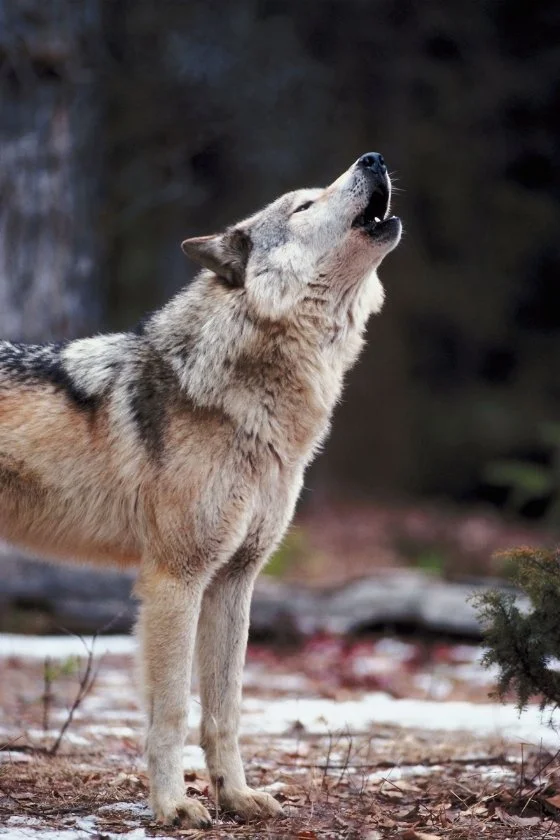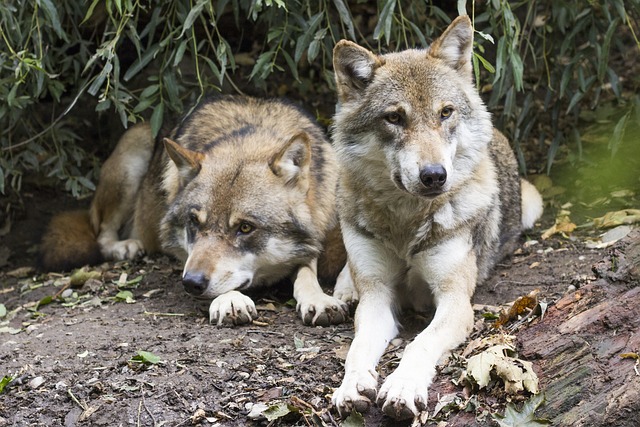Wolves are related to dogs, but there are many significant differences. One such difference is in the vocal sounds.
Their sounds serve various purposes like scaring enemies away from their turf or alerting wolf pups mothers of imminent danger.
Wolves communicate in several ways, occasionally making a dog-like barking sound. This makes people assume they bark exactly like dogs.
However, wolves do not bark like dogs. Dogs bark in many pitches and tones, but wolves bark more rapidly and repetitively. They also communicate with other sounds like snarling, howling, and whimpering to describe their moods.
Read on for more detailed information on how wolves communicate with sounds.
Do Wolves Bark Like Dogs?

Wolves do bark, a trait they share with dogs. However, they do not bark as often as dogs do, and the intent of barking for wolves is quite different from that of dogs.
Wolves also employ several other sound modes like howling, yipping, growling, whimpering, and barking. Howling is the most common sound.
Whimpering often represents a way of seeking attention, showing anxiety or frustration, and is used to show happiness.
Growling is mostly used among their packs to show defense or threat.
The beta females use barking to instruct the pups or warn them, and howling is used to ward off dangers from intruders, among other reasons.
Because wolves don’t often bark, some people assume they only howl. Barking is also considered juvenile behavior.
You can’t remove it from their list of sounds, however, as they employ it too.
Why Do Wolves Bark?
Typically, a wolf barks when alarmed. Like the human impulse of jumping or screaming to express suddenness, wolves may bark when scared by a sudden event and when caught unawares.
This is unlike dogs that may bark to express different emotions.
The bark of wolves is usually made together with other modes of communication.
An instance is when a wolf makes a bark-howl to warn other pack members against an intruder, and the bark-howl may not be heard long distances. A wolf may bark to send the intruder away.
Sending a warning signal is a core reason wolves bark. It serves to warn members of the pack of impending danger.
This alarm quickly calls the attention of all pack members to get ready to fight off the danger.
A mother wolf may bark as well, and not just to alert her pups of danger. She may use it to correct her pups or pass an instruction to them.
How Do Wolves Bark?
When wolves are about to bark, they huff like they want to, but they abruptly don’t get to the level of barking.
Wolves howl continuously in rapid spurts sounding like a bark, employing the same manner of communication as dogs but typically modified to fit the wildlife’s needs.
Barking does not always express the needs of wolves when they communicate.
Sometimes, they employ the combination of other sounds and the use of body language to express their thoughts, desires, and location or other needs with their pack. Barking is not the only means to communicate for wolves.
What About Howling? Why Do Wolves Howl?

There are several reasons a wolf can howl, one of which is a howl to mourn the death or passing of a pack member.1
They also use this sound to communicate with a lost wolf and/or seek directions. Howling can as well serve as a rally for a hunt, to declare a territory, or scare off other wolves from a fresh hunt. They can recognize the voices of members of their pack.
When wolves are howling at each other, they do so at different levels of pitch and tone.
This prevents the other rival from correctly estimating their numbers, leaving the said rival confused and unable to launch an attack.
Because cannot accurately count the number of wolves, they stand the danger of being defeated if the rival pack is lesser in number.
There are many myths associated with howling. It is often said that wolves howl at the moon for the sake of it, but that’s not accurate.
They are actually very careful when howling. Some customs and traditions believe wolves sit when howling, but on the contrary, they do not always sit when they howl. They can stand.
Wolves can sometimes howl when alone, but this is only for a short period before they join other members of the pack.
Howls are vital means of communication for wolves and are not commonly used as some people think they howl once or twice a day. They rather employ other modes.
The howl of a wolf can be heard 16km away (10 miles), and the howling lasts between 3-11 seconds.
Anyone can hear the howl of a wolf from far distances, which can warn intruders of a pack territory ahead.
If you are wondering when wolves howl the most, it is mostly before dawn, usually before the adult members of the pack go hunting and when returning.
When wolves breed and rear their pups, they howl more. A pack of wolves larger in number will howl more than a smaller pack.
The smaller packs tend to avoid being caught in a howling fight, as this can be bad when they are lesser in number.
How Do Wolves Communicate?

Wolves communicate mainly using three languages:
- Sounds and vocalization
- Special scents
- Body language
Sounds
The first language wolves employ in communicating is the use of sounds; they include barking, whimpering, howling, and growling.2
They mostly employ these four languages when communicating, and the mode of sound used is determined by the needs of the communication.
Special Scents
Another means through which wolves communicate is through special scents.
Wolves, just like dogs, have a great smell organ, the nose of a wolf is considered 100 times greater than that of humans, and they communicate using smells in different ways.
The special scents used for communication are urine, scats, and pheromones. Wolves mark their territories using scats and urine, known as scent marking.
When others that are not members of the pack perceive these scents, they know that territory belongs to another pack, and these scents can help track a lost member of a pack.
The Alpha wolf communicates through urination at intervals, and when this happens, a leg is raised, and this process is called RLU(raised leg urination).
Pheromones are another scent used by wolves in communicating, and they include glands on the eyes, skin, tail, anus, ties, and genitalia.
The alpha wolf can accurately predict the right time for mating by smelling the urine of the female wolf.
The urine of the beta wolf will help the alpha wolf know a beta wolf is in estrus (when it is likely to conceive) through pheromones in her urine.
Body Language
Another important means wolves communicate is through body language. Different body postures can be used to convey emotions.
A straightly stuck-up ear and baring of the teeth symbolize anger, a backward pulled ear and squint show suspicion, and a flattened ear leaning against the head shows fear. When wolves want to play dance, they bow playfully.
Wolves vs Dogs: Can Wolves Bark Like Dogs?

Wolves and dogs are capable of barking by genetics and biological makeup. However, the intent for barking differs.
Unlike wolves, dogs can bark for several reasons, including getting attention, communicating a need, expressing emotions, and sometimes due to some factors within their environment.
Unlike dogs, wolves combine barking with other communication modes to express emotions.
Several factors may be responsible for the barking of a dog. One major reason why dogs bark is to express their emotions.3
These emotions include; discomfort, uneasiness, anxiety, excitement, sadness, etc.
Dogs also bark to communicate their needs; for instance, a dog may bark when hungry or thirsty, bark when bored, lonely, alarmed, or need to be removed from the cage.
Another reason dogs bark can be due to the influence of the environment. For instance, a car horn can induce a dog to bark; loud noise and barking of another dog can also induce a dog to bark.
The training a dog receives also plays a major role in determining why a dog will bark.
Why Do Wolves’ Bark Differ from Dogs’?
One major reason wolves bark differs from dogs is their socialization. Changes occurred to the needs of dogs because of domestication by man.
Dogs had to modify their modes of passing information to fit into their new environment.
This evolution progressed across the generations. In the long run, dogs adjusted to living with humans by concluding that barking was the most effective communication method.
Wolves only bark when necessary and, due to the influence of their social group, bark when they sense danger.
They resort to using a combination of other modes of sound to communicate with members of their pack.
The biological makeup of wolves also plays a vital role in how they bark, which makes it different from that of dogs.
How to Differentiate a Dog Bark and a Wolf Bark
The bark of a wolf is different from that of a dog, the bark of wolves is lower-pitched, so they do not sound like dogs when they bark.
Also, their barks are communicated through intervals of howls similar to barks.
Wolves’ barks are brief and unique, unlike those of dogs, since they create a huffing sound that suggests they are about to let out a loud bark, but their barks don’t reach the pitch of dogs’ barks.
Wolves Howl vs Dogs Howl
It is important to note that a dog’s howl is similar to a wolf’s; a dog’s howl at night may be mistaken for a wolf’s and vice-versa.
On the other hand, the howl of a wolf is comparable to that of a dog. When a pack of dogs howls at night, they are sometimes mistaken for a pack of wolves.
A howling wolf can potentially be misidentified as a dog. As a result, if you hear anything howling at you from a distance, you should know whether you’re dealing with a dog or a wolf. If you’re unsure, move gently in the other way.
Frequently Asked Questions
How frequently do wolves bark?
Unlike dogs, wolves rarely bark except when alarmed, in danger, or they sense an intruder approaching their territory. They bark once and at most not more than twice a day, and sometimes they may not back at all. They are majorly induced to bark when there is a need for them to bark.
Why do dogs bark at night?
Dogs do not only bark during the day but also at night, which can be annoying for dog owners sometimes. Dogs bark at night for hunger, notice an intruder, are alarmed, lonely, bored, or maybe sad. Dogs typically bark at night for the same reasons they do during the day.
How do dogs communicate by barking?
The barking of dogs communicates many things at different times, as dogs majorly understand barking as the most effective method of communication. The functions of dog barks include; greeting, playing, alarming, attention-seeking, and expressing their emotions.
The pitch of dog barks depends on the breed, as some breeds bark at a high pitch. Mostly, when the pitch of a dog’s bark is very high, it signals an intruder or danger within.
Final Words
Wolves and dogs are considered the largest members of the canidae.
Wolves remain one of the most intelligent and dangerous predators of wildlife, which employ a different mode of sound to communicate with members of their pack.
References & Notes
- Mazzini F., Townsend W. S., et al. (2013). Wolf Howling Is Mediated by Relationship Quality Rather Than Underlying Emotional Stress. Current Biology.
- Theberge B. J., Falls J. B., (1967). Howling as a Means of Communication in Timber Wolves. American Zoologist.
- Hare B., Woods V. (2013). What Are Dogs Saying When They Bark? Scientific American.






